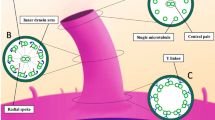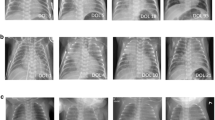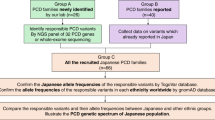Abstract
Diagnostic testing for primary ciliary dyskinesia (PCD) usually includes transmission electron microscopy (TEM), nasal nitric oxide, high-speed video microscopy, and genetics. Diagnostic performance of each test should be assessed toward the development of PCD diagnostic algorithms. We systematically reviewed the literature and quantified PCD prevalence among referrals and TEM detection rate in confirmed PCD patients. Major electronic databases were searched until December 2015 using appropriate terms. Included studies described cohorts of consecutive PCD referrals in which PCD was confirmed by at least TEM and one additional test, in order to compare the index test performance with other test(s). Meta-analyses of pooled PCD prevalence and TEM detection rate across studies were performed. PCD prevalence among referrals was 32% (95% CI: 25–39%, I2 = 92%). TEM detection rate among PCD patients was 83% (95% CI: 75–90%, I2 = 90%). Exclusion of studies reporting isolated inner dynein arm defects as PCD, reduced TEM detection rate and explained an important fraction of observed heterogeneity (74%, 95% CI: 66–83%, I2 = 66%). Approximately, one third of referrals, are diagnosed with PCD. Among PCD patients, a significant percentage, at least as high as 26%, is missed by TEM, a limitation that should be accounted toward the development of an efficacious PCD diagnostic algorithm.
Similar content being viewed by others
Log in or create a free account to read this content
Gain free access to this article, as well as selected content from this journal and more on nature.com
or
References
Boon M, Jorissen M, Proesmans M, De Boeck K. Primary ciliary dyskinesia, an orphan disease. Eur J Pediatr 2013;172:151–62.
Barbato A, Frischer T, Kuehni CE, et al. Primary ciliary dyskinesia: a consensus statement on diagnostic and treatment approaches in children. Eur Respir J 2009;34:1264–76.
Lucas JS, Burgess A, Mitchison HM, Moya E, Williamson M, Hogg C ; National PCD Service, UK. Diagnosis and management of primary ciliary dyskinesia. Arch Dis Child 2014;99:850–6.
Boon M, Meyts I, Proesmans M, Vermeulen FL, Jorissen M, De Boeck K. Diagnostic accuracy of nitric oxide measurements to detect primary ciliary dyskinesia. Eur J Clin Invest 2014;44:477–85.
Santamaria F, de Santi MM, Grillo G, Sarnelli P, Caterino M, Greco L. Ciliary motility at light microscopy: a screening technique for ciliary defects. Acta Paediatr 1999;88:853–7.
Leigh MW, O’Callaghan C, Knowles MR. The challenges of diagnosing primary ciliary dyskinesia. Proc Am Thorac Soc 2011;8:434–7.
Kim RH, A Hall D, Cutz E, et al. The role of molecular genetic analysis in the diagnosis of primary ciliary dyskinesia. Ann Am Thorac Soc 2014;11:351–9.
Lucas JS, Paff T, Goggin P, Haarman E. Diagnostic methods in primary ciliary dyskinesia. Paediatr Respir Rev 2016;18:8–17.
Hogg C. Primary ciliary dyskinesia: when to suspect the diagnosis and how to confirm it. Paediatr Respir Rev 2009;10:44–50.
Lucas JS, Leigh MW. Diagnosis of primary ciliary dyskinesia: searching for a gold standard. Eur Respir J 2014;44:1418–22.
Sox HC, Blatt MA, Higgins MC, Marton KI. Medical decision making. Philadelphia, PA: ACP Press 2007
Horani A, Brody SL, Ferkol TW. Picking up speed: advances in the genetics of primary ciliary dyskinesia. Pediatr Res 2014;75:158–64.
Schwabe GC, Hoffmann K, Loges NT, et al. Primary ciliary dyskinesia associated with normal axoneme ultrastructure is caused by DNAH11 mutations. Hum Mutat 2008;29:289–98.
Olbrich H, Cremers C, Loges NT, et al. Loss-of-function GAS8 mutations cause primary ciliary dyskinesia and disrupt the nexin-dynein regulatory complex. Am J Hum Genet 2015;97:546–54.
Stannard WA, Chilvers MA, Rutman AR, Williams CD, O’Callaghan C. Diagnostic testing of patients suspected of primary ciliary dyskinesia. Am J Respir Crit Care Med 2010;181:307–14.
Leigh MW, Hazucha MJ, Chawla KK, et al. Standardizing nasal nitric oxide measurement as a test for primary ciliary dyskinesia. Ann Am Thorac Soc 2013;10:574–81.
Boon M, Smits A, Cuppens H, et al. Primary ciliary dyskinesia: critical evaluation of clinical symptoms and diagnosis in patients with normal and abnormal ultrastructure. Orphanet J Rare Dis 2014;9:11.
Yiallouros PK, Kouis P, Middleton N, et al. Clinical features of primary ciliary dyskinesia in Cyprus with emphasis on lobectomized patients. Respir Med 2015;109:347–56.
Werner C, Onnebrink JG, Omran H. Diagnosis and management of primary ciliary dyskinesia. Cilia 2015;4:2.
Moher D, Liberati A, Tetzlaff J, Altman DG ; PRISMA Group. Preferred reporting items for systematic reviews and meta-analyses: the PRISMA statement. Ann Intern Med 2009;151:264–9, W64.
Stroup DF, Berlin JA, Morton SC, et al. Meta-analysis of observational studies in epidemiology: a proposal for reporting. Meta-analysis Of Observational Studies in Epidemiology (MOOSE) group. JAMA 2000;283:2008–12.
Nyaga VN, Arbyn M, Aerts M. Metaprop: a Stata command to perform meta-analysis of binomial data. Arch Public Health 2014;72:39.
Borenstein M, Hedges L, Rothstein H. Meta-analysis: fixed effect vs. random effects, 2007. https://www.meta-analysis.com/downloads/Meta-analysis%20fixed%20effect%20vs%20random%20effects.pdf.
IntHout J, Ioannidis JP, Borm GF. The Hartung-Knapp-Sidik-Jonkman method for random effects meta-analysis is straightforward and considerably outperforms the standard DerSimonian-Laird method. BMC Med Res Methodol 2014;14:25.
Higgins JP, Thompson SG. Quantifying heterogeneity in a meta-analysis. Stat Med 2002;21:1539–58.
O’Callaghan C, Rutman A, Williams GM, Hirst RA. Inner dynein arm defects causing primary ciliary dyskinesia: repeat testing required. Eur Respir J 2011;38:603–7.
Kurkowiak M, Ziętkiewicz E, Witt M. Recent advances in primary ciliary dyskinesia genetics. J Med Genet 2015;52:1–9.
Shoemark A, Dixon M, Corrin B, Dewar A. Twenty-year review of quantitative transmission electron microscopy for the diagnosis of primary ciliary dyskinesia. J Clin Pathol 2012;65:267–71.
Jackson CL, Behan L, Collins SA, et al. Accuracy of diagnostic testing in primary ciliary dyskinesia. Eur Respir J 2016;47:837–48.
Shapiro AJ, Davis S, Olivier K, et al. Clinical symptoms associated with primary ciliary dyskinesia–results of a multi-centered study. Am J Respir Crit Care Med 2010;181:A6728
Olm MA, Kögler JE Jr, Macchione M, Shoemark A, Saldiva PH, Rodrigues JC. Primary ciliary dyskinesia: evaluation using cilia beat frequency assessment via spectral analysis of digital microscopy images. J Appl Physiol (1985) 2011;111:295–302.
Pifferi M, Bush A, Caramella D, et al. Agenesis of paranasal sinuses and nasal nitric oxide in primary ciliary dyskinesia. Eur Respir J 2011;37:566–71.
Djakow J, Svobodová T, Hrach K, Uhlík J, Cinek O, Pohunek P. Effectiveness of sequencing selected exons of DNAH5 and DNAI1 in diagnosis of primary ciliary dyskinesia. Pediatr Pulmonol 2012;47:864–75.
Nauta F, Pals G, Daniels H, Nagelkerke A, Haarman E. Diagnosis of primary ciliary dyskinesia in a Dutch cohort of 63 pediatric patients: an overview. Eur Respir J 2011;38(Suppl 55):511
O’Callaghan C, Chilvers M, Hogg C, Bush A, Lucas J. Diagnosing primary ciliary dyskinesia. Thorax 2007;62:656–7.
Kuehni CE, Frischer T, Strippoli MP, et al.; ERS Task Force on Primary Ciliary Dyskinesia in Children. Factors influencing age at diagnosis of primary ciliary dyskinesia in European children. Eur Respir J 2010;36:1248–58.
Leigh MW, Ferkol TW, Davis SD, et al. Clinical features and associated likelihood of primary ciliary dyskinesia in children and adolescents. Ann Am Thorac Soc 2016;13:1305–13.
Behan L, Dimitrov BD, Kuehni CE, et al. PICADAR: a diagnostic predictive tool for primary ciliary dyskinesia. Eur Respir J 2016;47:1103–12.
Onoufriadis A, Shoemark A, Schmidts M, et al.; UK10K. Targeted NGS gene panel identifies mutations in RSPH1 causing primary ciliary dyskinesia and a common mechanism for ciliary central pair agenesis due to radial spoke defects. Hum Mol Genet 2014;23:3362–74.
Castleman VH, Romio L, Chodhari R, et al. Mutations in radial spoke head protein genes RSPH9 and RSPH4A cause primary ciliary dyskinesia with central-microtubular-pair abnormalities. Am J Hum Genet 2009;84:197–209.
Olin JT, Burns K, Carson JL, et al.; Genetic Disorders of Mucociliary Clearance Consortium. Diagnostic yield of nasal scrape biopsies in primary ciliary dyskinesia: a multicenter experience. Pediatr Pulmonol 2011;46:483–8.
Kouis P, Papatheodorou SI, Yiallouros PK. Diagnostic accuracy of nasal nitric oxide for establishing diagnosis of primary ciliary dyskinesia: a meta-analysis. BMC Pulm Med 2015;15:153.
Boon M, Jorissen M, Jaspers M, Cuppens H, De Boeck K. Is the sensitivity of primary ciliary dyskinesia detection by ciliary function analysis 100%? Eur Respir J 2013;42:1159–61.
Horani A, Ferkol TW, Dutcher SK, Brody SL. Genetics and biology of primary ciliary dyskinesia. Paediatr Respir Rev 2016;18:18–24.
Davis SD, Ferkol TW, Rosenfeld M, et al. Clinical features of childhood primary ciliary dyskinesia by genotype and ultrastructural phenotype. Am J Respir Crit Care Med 2015;191:316–24.
Knowles MR, Ostrowski LE, Leigh MW, et al. Mutations in RSPH1 cause primary ciliary dyskinesia with a unique clinical and ciliary phenotype. Am J Respir Crit Care Med 2014;189:707–17.
Ibañez-Tallon I, Heintz N, Omran H. To beat or not to beat: roles of cilia in development and disease. Hum Mol Genet 2003;12 Spec No 1:R27–35.
Bui KH, Sakakibara H, Movassagh T, Oiwa K, Ishikawa T. Asymmetry of inner dynein arms and inter-doublet links in Chlamydomonas flagella. J Cell Biol 2009;186:437–46.
Funkhouser WK 3rd, Niethammer M, Carson JL, et al. A new tool improves diagnostic test performance for transmission em evaluation of axonemal dynein arms. Ultrastruct Pathol 2014;38:248–55.
Escudier E, Couprie M, Duriez B, et al. Computer-assisted analysis helps detect inner dynein arm abnormalities. Am J Respir Crit Care Med 2002;166:1257–62.
Antony D, Becker-Heck A, Zariwala MA, et al.; Uk10k. Mutations in CCDC39 and CCDC40 are the major cause of primary ciliary dyskinesia with axonemal disorganization and absent inner dynein arms. Hum Mutat 2013;34:462–72.
Zariwala MA, Knowles MR, Leigh MW. Primary ciliary dyskinesia. In: Pagon RA, Adam MP, Ardinger HH, et al., eds. GeneReviews(R). Seattle, WA: University of Washington, 2015.
Acknowledgements
The sponsors had no role or involvement in study design; in the collection, analysis and interpretation of data; in the writing of the report; and in the decision to submit the article for publication.
Author information
Authors and Affiliations
Corresponding author
Supplementary information
Supplementary Table S1
(DOCX 20 kb)
Supplementary Table S2
(DOCX 13 kb)
Supplementary Figures
(PDF 762 kb)
Rights and permissions
About this article
Cite this article
Kouis, P., Yiallouros, P., Middleton, N. et al. Prevalence of primary ciliary dyskinesia in consecutive referrals of suspect cases and the transmission electron microscopy detection rate: a systematic review and meta-analysis. Pediatr Res 81, 398–405 (2017). https://doi.org/10.1038/pr.2016.263
Received:
Accepted:
Published:
Issue date:
DOI: https://doi.org/10.1038/pr.2016.263
This article is cited by
-
Genetic spectrum and genotype–phenotype correlations in DNAH5-mutated primary ciliary dyskinesia: a systematic review
Orphanet Journal of Rare Diseases (2025)
-
An indigenous method of high-speed video microscopy for diagnosis of primary ciliary dyskinesia in children
World Journal of Pediatrics (2025)
-
Recognizing clinical features of primary ciliary dyskinesia in the perinatal period
Journal of Perinatology (2024)
-
Clinical and genetic features of primary ciliary dyskinesia in a cohort of consecutive clinically suspect children in western China
BMC Pediatrics (2022)
-
Motile ciliopathies
Nature Reviews Disease Primers (2020)



